
Cycas: planting and care
Contents
Cycas in a nutshell
- The cycad is a shrub with an archaic and exotic appearance, closely related to palms
- Half-fern, half-palm, it showcases an extraordinary crown of elegantly cut and slightly arched green leaves
- Frost-sensitive, it is only planted in the ground along the Mediterranean or Atlantic coast; elsewhere, it will also thrive in a large pot kept away from the cold
- It is easy to grow in regions where frost does not occur
- A choice landscape subject in a coastal garden or a star plant for a conservatory!
A word from our expert
Cycad is a beautiful shrub with a short, rough trunk and stunning exotic foliage, providing a very unusual atmosphere in the garden all year round! Closely related to palms, it forms a brown, fibrous stipe, at the top of which unfolds superb green foliage resembling a fern.
Its elegantly divided leaves and silhouette, reminiscent of prehistoric times, will express their full potential when planted alone or in a large rockery. Among the most sought-after cycads, the Cycas revoluta is a particularly ornamental species, highly valued in landscape design.
Generally, it does not exceed 2 m in height.
Semi-hardy, its cultivation in open ground is only possible along the Mediterranean or Atlantic coast; elsewhere, it will thrive in a large pot to be stored away in winter or grown indoors all year round.
In gardens spared from frost, Cycas enjoys full sun in well-draining soil. Its compact size and ease of cultivation make it suitable for pot or container growing in our coldest regions.
It is perfect for integrating into an exotic-style garden, alongside other lush foliage, and in a coastal or Mediterranean garden.
Choose your Cycas to add a touch of exoticism to your garden, terrace, or conservatory depending on your region!
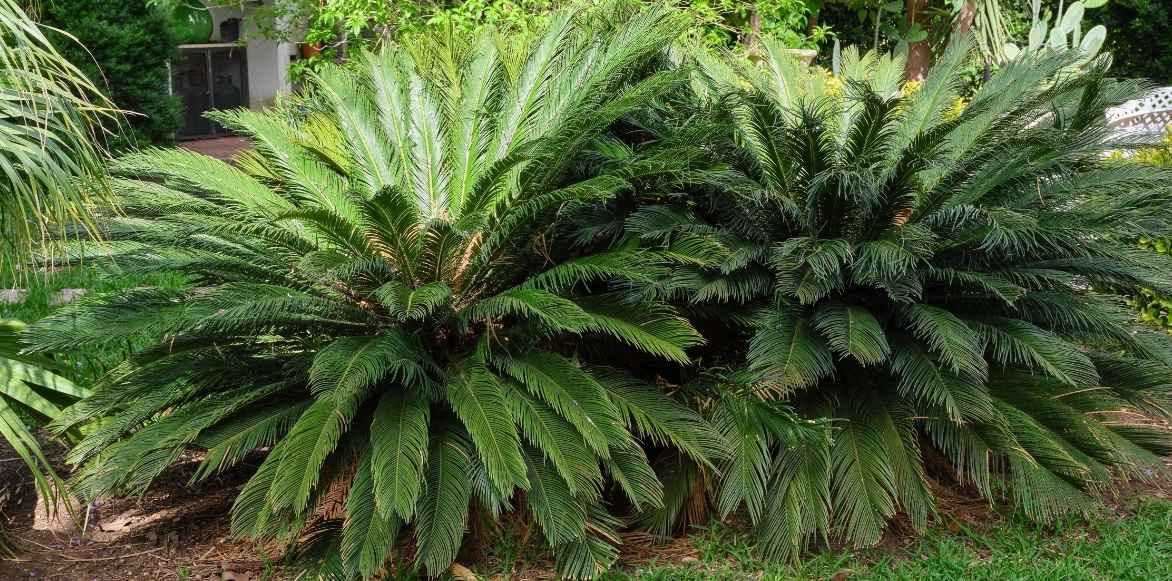
A very exotic duo of Cycas
Description and botany
Botanical data
- Latin name Cycas
- Family Cycadaceae
- Common name Fern-palm, Mini-palm
- Flowering June to August
- Height 0.60 to 2 m
- Exposure sun
- Soil type rich and light
- Hardiness frost-sensitive
The genus Cycas comprises around fifteen species, including Cycas revoluta, which is the most commonly cultivated due to its relative hardiness. They belong to the family Cycadaceae, a very ancient botanical family. The Cycas is a prehistoric plant that has survived from primitive times. The first fossils of the genus Cycas appeared 66 million years ago. It grows naturally on dry, rocky slopes and meadows or in arid, open forests from Madagascar to Southeast Asia, Australia, and the Pacific Islands.
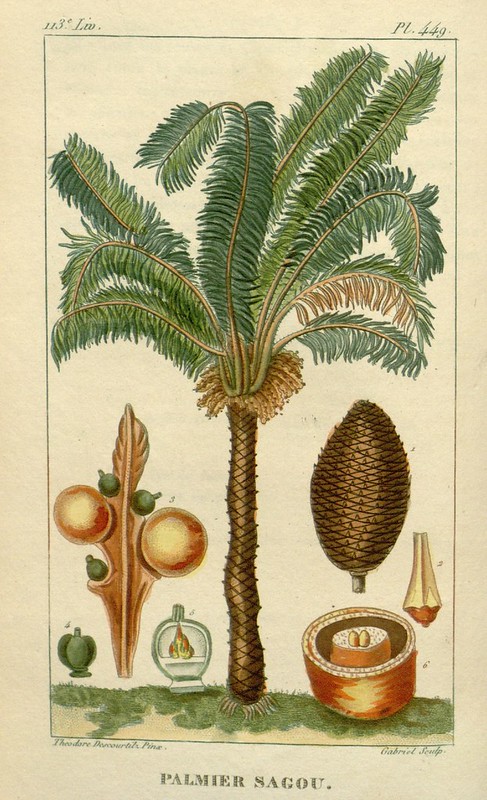
Botanical plate of the Sago Palm, Medical Flora of the Antilles (circa 1825)
From a botanical perspective, the Cycas exhibits intermediate characteristics between tree ferns and palms, which is why it is sometimes referred to as a “fern-palm” or “false palm”.
The Cycas is appreciated for its unique ornamental appearance that bridges the gap between ferns and palms. In its natural habitat, Cycas revoluta can reach heights of 6 m, and up to 10 m for Cycas circinalis or “grand cycas”. In cultivation, under our climates, this plant rarely exceeds 1.5 m in any direction. It is a slow-growing pseudo-palm that does not become very tall.
However, it is a plant of considerable size with an upright, bushy palm-like habit. After a few years, it develops a wide, short, stout, conical trunk, covered in woolly hairs, known as a “stipe”, similar to palms. The Cycas eventually forms a small fossil tree typically consisting of a single stipe, but it may tend to branch and lean over time, especially in Cycas revoluta. The surface of this false trunk, covered in brown fibers and rough texture, bears foliar scars characteristic of the bases of the stems that support the leaves.
A magnificent, compact, and very spreading crown of leaves develops at the tip of the stipe. The Cycas possesses large, impressive leaves full of exoticism.
This evergreen foliage, arranged in a concentric rosette, consists of numerous (40 to 100) long pinnate leaves, more rarely bipinnate, glossy, stiff, and leathery, measuring 70 cm to 2 m long and 15 to 25 cm wide. They emerge in the form of croziers that unfurl like fern fronds. Beautifully arched, once fully opened, they create an elegant curve. Each leaf is attached to the stipe by a thick petiole edged with thorns. They are divided into numerous linear leaflets that taper to spiny tips.
The leaves are generally green, ranging from lime green to dark green, but can also take on more bluish hues, depending on the varieties. Young shoots display lighter shades. The leaf crown remains decorative in winter and renews itself approximately every 1 to 2 years.
Inflorescences appear in summer, after many years of cultivation, at the centre of the leaf crown. The flowers emerge in the form of quite impressive cones. It is a dioecious plant, with distinct male and female plants. Both male and female plants are needed to produce seeds. Male cycas develop a large erect cone measuring 30 to 80 cm long, formed of light yellow woolly scales containing pollen grains. Female plants bear beautiful inflorescences; the flowers are gathered in rosettes of smaller “leaves” measuring 15-30 cm, ochre-yellow or reddish in colour and velvety, with a few fluffy ovules. Flowering only occurs on mature specimens and is almost non-existent in potted plants.
When pollination of the female plants occurs (a pollen grain falls on a mature ovule), the latter develops large bright red seeds measuring 3 to 4 cm long, slightly flattened.
Caution: leaves, flowers, fruits, the entire plant is toxic if ingested.
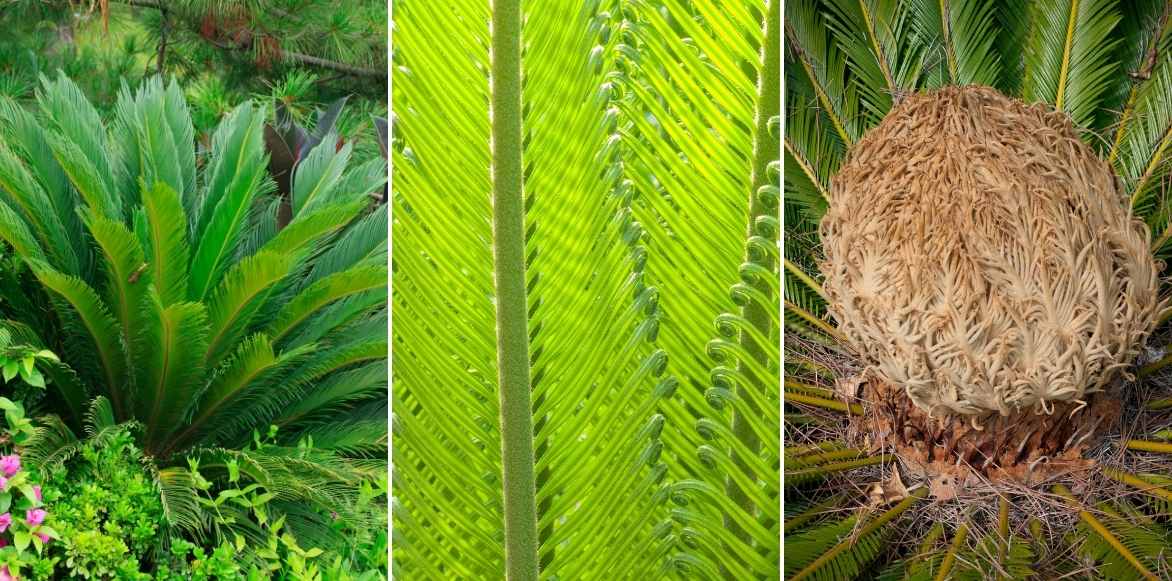
Cycas revoluta: habit, foliage, and flower
Read also
How to protect Cycas in winter?Main species and varieties
[product sku=”83284″ blog_description=”One of the most beautiful cycads! It resembles a palm tree with its lovely crown of leaves! A particularly ornamental species, highly sought after in landscape art.” template=”listing1″ /]
Planting Cycas
Where to plant it?
Naturally very frost-sensitive, growing cycas in open ground is only possible in regions spared from frost. Cycas revoluta or C. panzihuaensi are less sensitive to cold than their relatives, displaying some hardiness, but this does not exceed -6/-8°C in very sheltered situations. Therefore, the cultivation of this native of desert areas should be reserved for Mediterranean (orange zone) or Atlantic climates. Its good tolerance to sea spray makes it a suitable plant for a coastal garden. In cold and damp regions, growing it in a very large pot to be brought out in the fine season and stored in a veranda or greenhouse during winter, or in a sunny, bright room that is not too heated in winter, is more advisable.
In mild regions, provide it with a spot in full sun as it requires significant brightness and shelter from prevailing winds. It shows good resistance to drought once well established.
It needs a very well-drained substrate in which it will be more hardy. It fears stagnant moisture, especially when combined with cold and heavy, clayey soils in winter, preferring soil that remains cool in summer and rather dry in winter. A rich, humus-bearing, perfectly well-drained soil will suit it. If your ground retains too much water, do not hesitate to improve drainage during planting by adding gravel or pumice, or plant on a mound or rocky slope to prevent it from sitting in water.
This is a fairly compact type of palm and easy to grow in a large container on a terrace, which is a good solution if you live in a region with a harsh climate!
In the garden, it fits perfectly at the centre of an exotic bed, as a specimen plant, in a large rockery, or by the edge of a pool.
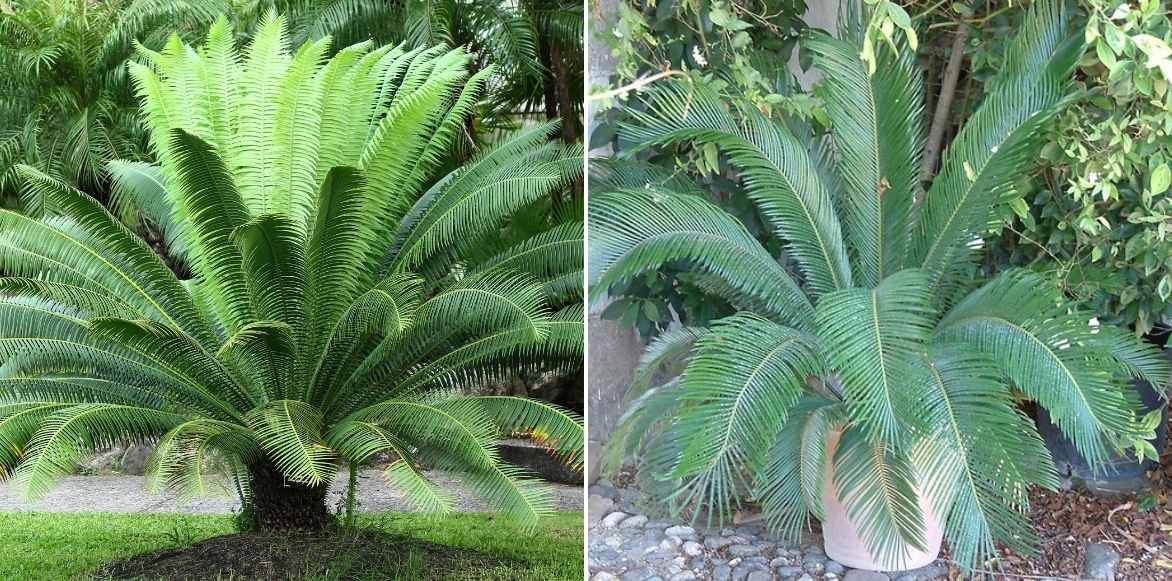
Reserve a prime spot for your cycas: on the left as a specimen, or in a large pot on the right (© Alex Lomas)
When to plant?
Containerised cycas should be planted in the garden in spring from March to June after the frosts, or in late summer from September to October in mild climates.
How to plant?
In open ground
If the soil is insufficiently drained, it is advisable to lighten it beforehand with gravel, small stones, or coarse sand mixed with the soil to improve drainage.
- Loosen the soil well
- Dig a hole 2 to 3 times the volume of the pot
- Plant the bush upright in the centre on a good layer of spread gravel at the bottom of the hole
- Fill with a mixture of equal parts garden soil, potting soil, compost, and 1/3 sand
- Avoid burying the base of the stipe
- Lightly compact
- Water generously at planting and then regularly during its first growing season to help it root well
- You can apply mulch around the base to keep the soil cool
In a pot
Cycas performs very well in a pot to be placed on the terrace in fine weather and brought indoors in winter in cold regions. Below 5°C, bring it inside!
- Choose a large, deep container
- Install a drainage layer at the bottom (clay balls, pumice, about 20% of the pot’s volume)
- Plant your cycas in a draining substrate made of potting soil, compost, and 1/3 sand
- Avoid burying its collar
- Water generously
Read also
Mealybug: identification and treatmentCaring for Cycas
In the ground
It is a common misconception that Cycas prefers dry conditions. In reality, it thrives in soils that remain cool during summer. Your Cycas just needs a few regular waterings, but without excess, once a week during its first two summers in the garden to establish its roots. In subsequent years, only water during prolonged dry spells. In winter and outdoors, let nature take its course; it will be content with rainwater!
It is quite nutrient-hungry, so we recommend adding fertiliser or well-decomposed compost, or even ground horn, guano, or dried blood in spring.
It will appreciate winter protection against the cold, especially during the first two or three years, with a winter cover and mulching, particularly if you do not live in a mild climate.
Regularly remove the leaves that dry at the base of the stipe.
In a pot
When in pots, Cycas require a bit more attention. Water regularly, about once a week during the growth period, but allow the soil to dry out before watering again to prevent root rot.
Apply fertiliser approximately every 15 days in spring and summer.
For winter, bring indoors or into a greenhouse (at 12-15°C) the specimens you are growing in pots if you live in a cold region. Place them in a bright spot with some direct sunlight. You can take them back outside in spring when the risk of frost has passed. Reduce watering in winter to once every 15 days if the ambient temperature is below 15 °C—always allowing the substrate to dry out a bit between waterings, and stop fertiliser applications. Occasionally mist the foliage, especially in winter if the atmosphere is dry.
Repot every three to four years in spring to refresh the substrate and place the plant in a slightly larger pot each time. For Cycas that are difficult to repot, top-dress by adding a layer of compost about 1/3 thick.
⇒ Discover our tips for protecting your Cycas in winter and growing Cycas in pots
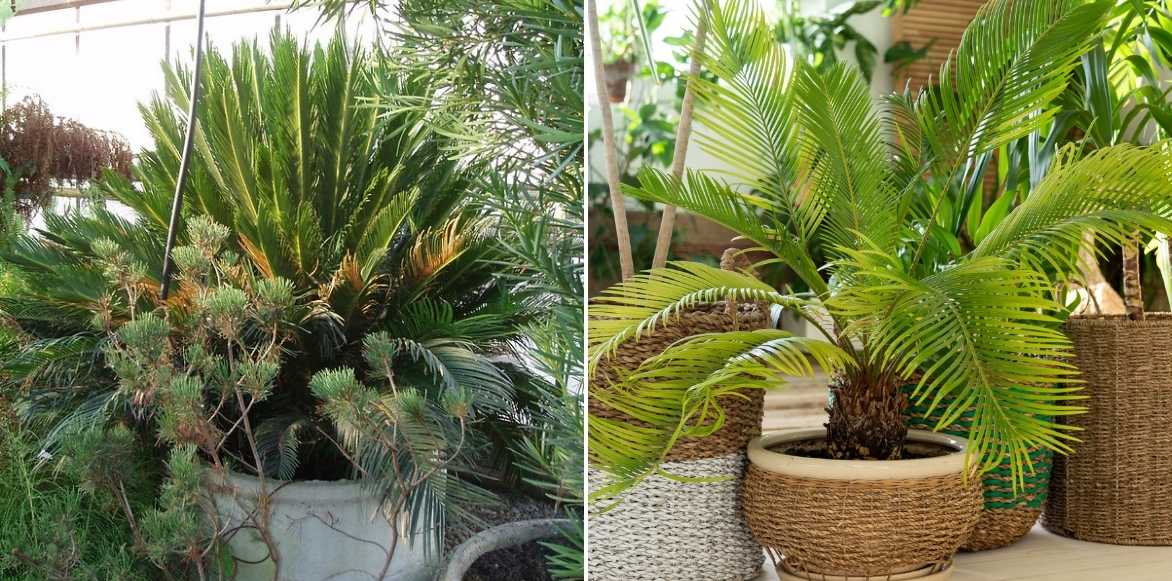
Planting in a pot requires a conservatory or winter garden, outside of mild climate regions (photo on the left © Montegon)
Diseases and potential pests
Cycas grown indoors are more susceptible to infestations, especially in overly dry and poorly ventilated conditions. Red spider mites can cause discolouration of the leaves; regular misting with non-calcareous water will often suffice to prevent or dislodge them.
In cases of excessively dry and confined atmospheres, the Cycas may also suffer from attacks by mealybugs, which leave small cottony white clusters on the leaves: remove the unwanted pests with a cotton pad soaked in 90°C alcohol. Then proceed with sprays of rapeseed oil and repeat if necessary two or three times at 15-day intervals.
In the garden, if small black insects appear (thrips), shower the foliage in the evening to drive them away.
→ Learn more in our advice sheet: Diseases and pests of Cycas or Japanese sago.
Multiplication
While it is always possible to propagate Cycas using its own seeds, this process is quite tedious. We do not recommend it for amateur gardeners, as germination is very slow.
→ To learn more about its propagation, also read our article: “Cycas: how to separate and replant new shoots?”.
Pairing ideas
With its finely dissected leaves resembling those of ferns, and its obvious archaic character, the Cycas is always a stunning focal point in a garden or in a pot on a balcony or terrace.
Beautiful all year round, it always brings grandeur and exoticism to a decor. It is a prime subject in exotic-inspired gardens, contemporary or Mediterranean.
It often stands alone and can be a bit difficult to pair due to its strong personality!
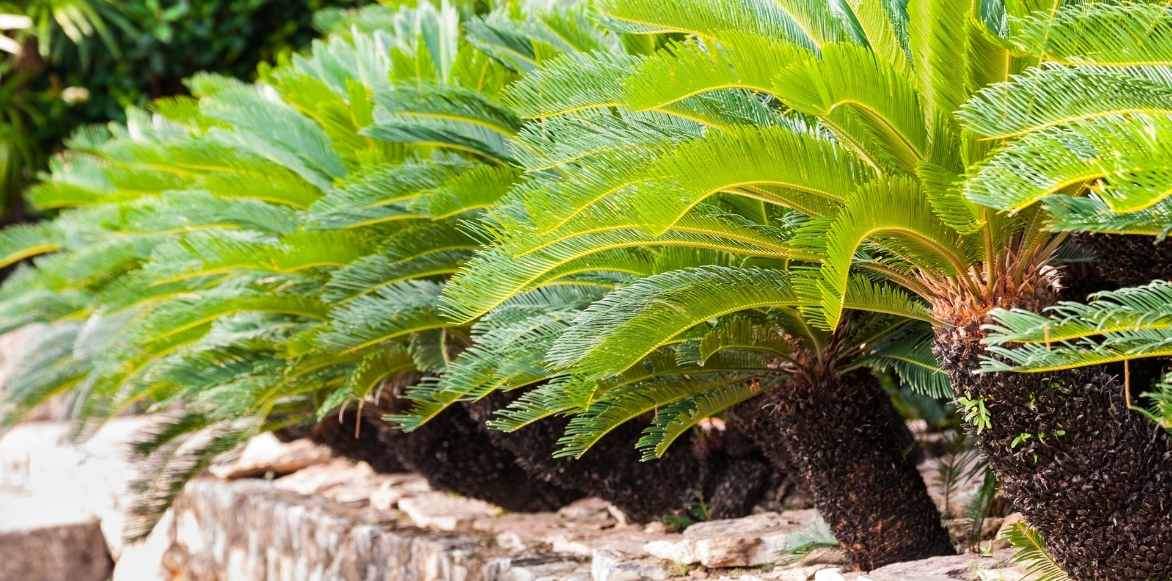 A stunning alignment of Cycas!
A stunning alignment of Cycas!
To create beautiful scenes with an exotic flair, plant it alongside Yucca, whose elegant silhouette also resembles that of palms, the original flowering of Hedychium, forming floral spikes in warm colours, and Tetrapanax Rex, banana plants (for example, Musa basjoo). In a contemporary garden, mineral and minimalist, it pairs beautifully above a sea of white pebbles with cordylines, phormiums, miniature palms, or Agaves.
It is ideal for adding relief to a bed of colourful perennials, where you can integrate the flamboyant flowers of crocosmias, kniphofias, bird of paradise, or cannas.
Planted in groups of three, underplant them with a carpet of Mouse Ear or Felicia or Cape aster.
In a pot on a terrace, surround it with citrus trees, strelitzias, or banana plants.
→ Discover more beautiful association ideas around Cycas in our advice sheet!
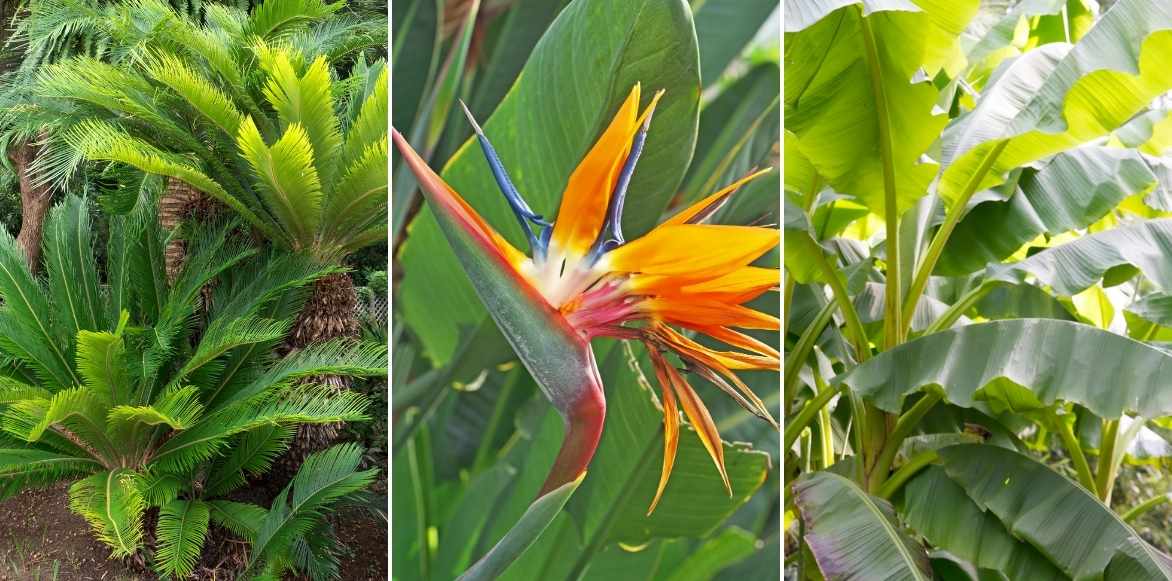 On the terrace, alongside Bird of Paradise and banana plants.
On the terrace, alongside Bird of Paradise and banana plants.
Useful resources
-
- Exotic, graphic, how to create a exotic garden?
- Which exotic plants to accompany your Cycas?
- What are the most graphic plants to create a minimalist and clean atmosphere?
- Article: Cycas in 10 questions and answers
Frequently asked questions
-
Why are the leaves of my Cycas turning yellow?
Several causes are possible: Cycas can turn yellow when they lack water. This may also be due to an atmosphere that is too dry or to overexposure to sunlight. Plants grown behind a window can suffer from leaf burn. Prefer less direct light. Cut the yellowing stems with pruning shears. An excess of water may also be the cause of the yellowing leaves. Its worst enemy is stagnant moisture, so banish water-retaining trays. Repot in fresh, well-draining soil, ensuring to spread a good layer of gravel at the bottom of the pot beforehand. A nitrogen deficiency also results in yellowing leaves. Adding turf and/or compost at the base of the plant can help correct the problem.
- Subscribe!
- Contents































Comments